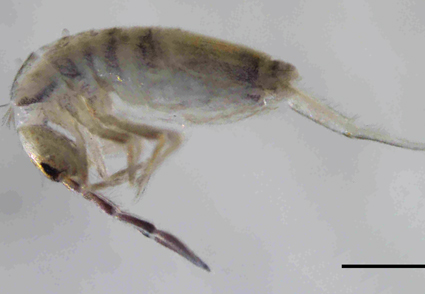Abstract
Here, the first record of Seira dowlingi from Asia is reported and its newly generated mitogenome is compared with Neotropical specimens. Molecular analyses were performed based on low-coverage whole-genome sequencing and the complete mitogenome was assembled using NovoPlasty. Our results show that the Chinese specimens have the same color pattern, chaetotaxy, and almost identical mitogenomes, differing only on three nucleotides located in protein-coding genes. A maximum-likelihood phylogeny based on 13 mitochondrial genes was made and the specimens’ similarity was confirmed, as well as its phylogenetic position. Considering the large geographic distance between the American and the Asiatic populations, we believe that the presence of S. dowlingi in China is a result of anthropogenic introduction. The data generated here can be useful for further phylogeographic studies related to Seirinae subfamily or Collembola fauna in general.
References
Alikhan, N.F., Petty, N.K., Ben Zakour, N.L. & Beatson, S.A. (2011) BLAST Ring Image Generator (BRIG): Simple prokaryote genome comparisons. BMC Genomics, 12, 1–10. https://doi.org/10.1186/1471-2164-12-402
Arlé, R. (1939) Relatório da excusão científica do Instituto Osvaldo Cruz realizada na zona da E. F. N.O.B. em outubro de 1938. Boletim Biológico, IV, 295–300.
Arlé, R. & Mendonça, C. (1982) Estudo preliminar das espécies de Dicranocentrus Schött, 1893, ocorrentes no Parque Nacional da Tijuca, Rio de Janeiro (Collembola). Revista Brasileira de Biologia, 42, 41–49.
Bellinger, P.F., Christiansen, K.A. & Janssens, F. (1996–2021) Checklist of the Collembola of the World. Available from: http://www.collembola.org (accessed 10 January 2021)
Bellini, B.C., Pais, A.P. & Zeppelini, D. (2009) A new species of Seira Lubbock (Collembola: Entomobryidae) from Brazil with sexually dimorphic legs. Zootaxa, 2080 (1), 38–46. https://doi.org/10.11646/zootaxa.2080.1.3
Bellini, B.C., Santos, N.M.C., Souza, P.G.C. & Weiner, W.M. (2018) Two new species of Brazilian springtails (Hexapoda : Collembola) with comments on Neotropical Brachystomella Ågren and Seira (Lepidocyrtinus) Börner. Insect Systematics and Evolution, 1–30. [published online] https://doi.org/10.1163/1876312X-00002192
Chernomor, O., von Haeseler, A. & Minh, B.Q. (2016) Terrace aware data structure for phylogenomic inference from supermatrices. Systematic Biolology, 65, 997–1008. https://doi.org/10.1093/sysbio/syw037
Christiansen, K.A. & Bellinger, P. (2000) A Survey of the Genus Seira (Hexapoda: Collembola: Entomobryidae). Caribbean Journal of Science, 36, 39–75.
Cicconardi, F., Borges, P.A.V., Strasberg, D., Oromí, P., López, H., Pérez-Delgado, A.J., Casquet, J., Caujapé-Castells, J., Fernández-Palacios, J.M., Thébaud, C. & Emerson, B.C. (2017) MtDNA metagenomics reveals large-scale invasion of belowground arthropod communities by introduced species. Molecular Ecology, 26, 3104–3115. https://doi.org/10.1111/mec.14037
Cipola, N.G., De Morais, J.W. & Bellini, B.C. (2017) The discovery of Lepidocyrtoides Schött, 1917 (Collembola, Entomobryidae, Entomobryinae) from the New World, including three new species from Brazil and one from Australia. Zootaxa, 4324 (2), 201–248. https://doi.org/10.11646/zootaxa.4324.2.2
Cipola, N.G., Godeiro, N.N. & Bellini, B.C. (2019) Scientific Note New records of Seira dowlingi ( Wray , 1953 ) (Collembola, Entomobryidae, Seirinae) for New World. Entomological Communications, 1, 1–3. https://doi.org/10.37486/2675-1305.ec01003
Dierckxsens, N., Mardulyn, P. & Smits, G. (2017) NOVOPlasty: De novo assembly of organelle genomes from whole genome data. Nucleic Acids Research, 45, e18. https://doi.org/10.1093/nar/gkw955
Godeiro, N.N., Zhang, F. & Cipola, N.G. (2020) First partial mitogenome of a new Seira Lubbock species (Collembola, Entomobryidae, Seirinae) from Cambodia reveals a possible separate lineage from the Neotropical Seirinae. Zootaxa, 4890 (4), 451–472. https://doi.org/10.11646/zootaxa.4890.4.1
Imms, A.D. (1912) On some Collembola from India, Burma and Ceylon, with a catalogue of the Oriental species of the Order. Proceedings of the Zoological Society of London, 6, 80–125. https://doi.org/10.1111/j.1469-7998.1912.tb07006.x
Jacquemart, S. (1980) Collemboles entomobryens nouveaux d’Afrique centrale. Bulletin—Institut Royal des sciences naturelles. Entomologie, 52 (14), 1–15.
Jordana, R., Arbea, J.I., Simón, C. & Luciáñez, M.J. (1997) Fauna Iberica. Vol. 8. Collembola, Poduromorpha. 1st Edttion Museo Nacional de Ciencias Naturales, Consejo Superior de Investigaciones Científicas, Madrid, pp. 1–807.
Kottek, M., Grieser, J., Beck, C., Rudolf, B. & Rubel, F. (2006) World map of the Köppen-Geiger climate classification updated. Meteorologische Zeitschrift, 15, 259–263. https://doi.org/10.1127/0941-2948/2006/0130
Lubbock, J (1871) Notes on the Thysanura. Part IV. Transactions of the Linnean Society of London, 27, 279–280, pls. 2. https://doi.org/10.1111/j.1096-3642.1870.tb00214.x
Minh, B.Q., Schmidt, H.A., Chernomor, O., Schrempf, D., Woodhams, M.D., von Haeseler,A. & Lanfear, R. (2020) IQ-TREE 2: New models and efficient methods for phylogenetic inference in the genomic era. Molecular Biology and Evolution, 37 (5), 1530–1534. https://doi.org/10.1093/molbev/msaa015
Soto-Adames, F.N. (2008) Postembryonic development of the dorsal chaetotaxy in Seira dowlingi (Collembola, Entomobryidae); with an analysis of the diagnostic and phylogenetic significance of primary chaetotaxy in Seira. Zootaxa, 1683 (1), 1–31. https://doi.org/10.11646/zootaxa.1683.1.1
Wray, D.L. (1953) Some new species of springtail insects (Collembola). Nature notes, 1, 1–7.
Zhang, F., Pan, Z., Wu, J., Ding, Y., Yu, D. & Wang, B. (2016) Dental scales could occur in all scaled subfamilies of Entomobryidae (Collembola): New definition of Entomobryinae with description of a new genus and three new species. Invertebrate Systematics, 30, 598–615. https://doi.org/10.1071/IS16005


